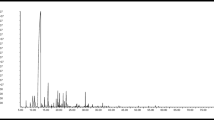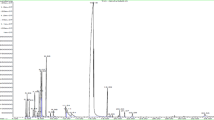Abstract
Thymus pallescens de Noé essential oils were isolated from the plant’s dried leaves, by hydrodistillation, with different distillation times (30 min, 1, 2 and 3 h). The essential oils compositions and their antioxidant, antimicrobial and insecticidal activities were examined. The chemical compositions of the oils were determined by GC and GC-MS. The antioxidant capacity was tested by four complementary methods: thiobarbituric acid reactive substances, ferric reducing power and scavenging of radicals DPPH• (2,2-diphenyl-1-picrylhydrazyl) and ABTS•+ [2,2′-azino-bis (3-ethylbenzthiazoline-6-sulfonic acid)]. The antimicrobial activity was tested against three bacteria, two gram-positive (Staphylococcus aureus and Bacillus subtilis) and one gram-negative (Escherichia coli) and one yeast (Candida albicans). The insecticidal activity against confused flour beetle Tribolium confusum Jacquelin du Val (Coleoptera: Tenebrionidae) was evaluated using direct contact application and fumigant method. The predominant components in the oils were carvacrol (63.3–68.2 %), γ-terpinene (6.9–9.1 %), p-cymene (6.2–10.3 %) and thymol (6.5–7.5 %). The antioxidant activities were dependent on the time of hydrodistillation and the method used. The essential oils extracted for 30 min and 1 h were the most efficient against all the bacteria used. Toxicity tests against T. confusum showed that the oils isolated for 3 h and 30 min caused highest mortality with contact method and fumigant test, respectively. The results suggest that distillation time can determine the value of the oil designed to be applied to any biological material.
Similar content being viewed by others
References
Maksimovic Z., Stojanovic D., Sostaric I., Dajic Z., Ristic M.: Composition and radical-scavenging activity of Thymus glabrescens Willd. (Lamiaceae) essential oil. J. Sci. Food Agric. 88, 2036–2041 (2008)
Evans W.C.: Trease and Evans’ Pharmacognosy. Baillière Tindall, London (1998)
Senatore F.: Influence of harvesting time on yield and composition of the essential Oil of a Thyme (Thymus pulegioides L.) growing wild in Campania (Southern Italy). J. Agric. Food Chem. 44, 1327–1332 (1996)
Bozin B., Mimica-Dukic N., Simin N., Anackov G.: Characterization of the volatile composition of essential oils of some Lamiaceae spices and the antimicrobial and antioxidant activities of the entire oils. J. Agric. Food Chem. 54, 1822–1828 (2006)
Ehivet F.E., Min B., Park M.K., Oh J.H.: Characterization and antimicrobial activity of sweet potato starch-based edible film containing origanum (Thymus capitatus) oil. J. Food Sci. 76, 178–184 (2011)
Halliwell B., Gutteridge J.M.C.: Free Radicals in Biology and Medicine. Oxford University Press, Oxford (2007)
Zheng W., Wang S.W.: Antioxidant activity and phenolic compounds in selected herbs. J. Agric. Food Chem. 49, 5165–5170 (2001)
Li H.B., Wong C.C., Cheng K.W., Chen F.: Antioxidant properties in vitro and total phenolic contents in methanol extracts from medicinal plants. LWT-Food Sci. Technol. 41, 385–390 (2008)
Ames B.M.: Dietary carcinogens and anticarcinogens: oxygen radical and degenerative diseases. Science 221, 1256–1263 (1983)
Baardseth P.: Effect of selected antioxidants on the stability of dehydrated mashed potatoes. Food Addit. Contam. 6, 201–207 (1989)
Burt S.: Essential oils: their antibacterial properties and potential applications in foods. Int. J. Food Microbiol. 94, 223–253 (2004)
Carson C.F., Hammer K.A., Riley T.V.: Melaleuca alternifolia (tea tree) oil: a review of antimicrobial and other medicinal properties. Clin. Microbiol. Rev. 19, 50–62 (2006)
González-Lamothe R., Mitchell G., Gattuso M., Diarra M.S., Malouin F., Bouarab K.: Plant antimicrobial agents and their effects on plant and human pathogens. Int. J. Mol. Sci. 10, 3400–3419 (2009)
Jeon Y.H., Sun X., Kim M.: Antimicrobial activity of the ethanol extract from Rubus coreanum against microorganism related with foodborne illness. Korean J. Food Cook. Sci. 28, 9 (2012)
Lee J.H., Kim I.H.: Antimicrobial activity and stability of tetrasodium pyrophosphate peroxidate. Korean J. Food Sci. Technol. 30, 1040–1044 (1998)
Ahmed S., Grainge M., Hylin J.W., Mitchel W.C., Litsinger J.A.: Some promising plant species for use as pest control agents under traditional farming systems. In: Schmutterer, H., Ascher, K.R.S. (eds) Natural Pesticides from the Neem Tree and Other Tropical Plants, GTZ, Eschborn (1984)
Madrid F.J., White N.D.G., Loschiavo S.R.: Insects in stored cereals, and their association with farming practices in southern Manitoba. Can. Entomol. 122, 515–523 (1990)
Isman M.B.: Botanical insecticides, deterrents, and repellents in modern agriculture and an increasingly regulated world. Annu. Rev. Entomol. 51, 45–66 (2006)
Riebeiro B.M., Guedes R.N.C., Oliveira E.E., Santos J.P.: Insecticide resistance and synergism in Brazilian populations of Sitophilus zeamais (Coleoptera: Curculionidae). J. Stored Prod. Res. 39, 21–31 (2003)
Barnard M., Padgitt M., Uri N.D.: Pesticide use and its measurement. Int. Pest Control 39, 161–164 (1997)
Misra G., Pavlostathis S.G.: Biodegradation kinetics of monoterpenes in liquid and soil-slurry systems. Appl. Microbiol. Biotechnol. 47, 572–577 (1997)
Kim S.I., Park C., Ohh M.H., Cho H.C., Ahn Y.J.: Contact and fumigant activities of aromatic plant extracts and essential oils against Lasioderma serricorne (Coleoptera: Anobiidae). J. Stored Prod. Res. 39, 11–19 (2002)
Hazzit M., Baaliouamer A., Faleiro M.L., Miguel M.G.: Composition of the essential oils of Thymus and Origanum from Algeria and their antioxidant and antimicrobial activities. J. Agric. Food Chem. 54, 6314–6321 (2006)
Hazzit M., Baaliouamer A., Verissimo A.R., Faleiro M.L., Miguel M.G.: Chemical composition and biological activities of Algerian Thymus oils. Food Chem. 116, 714–721 (2009)
Hazzit M., Baaliouamer A.: Variation of essential oil yield and composition of Thymus pallescens de Noé from Algeria. J. Essent. Oil Res. 21, 162–165 (2009)
Hazzit M., Baaliouamer A.: Composition of the essential oils of the leaves and flowers of Thymus pallescens de Noé and Origanum floribundum Munby from Algeria. J. Essent. Oil Res. 21, 267–270 (2009)
Hazzit M., Baaliouamer A., Douar-Latreche S.: Effect of heat treatment on the chemical composition and the antioxidant activity of essential oil of Thymus pallescens de Noé from Algeria. J. Essent. Oil Res. 25, 308–314 (2013)
Council of Europe: European directorate for quality of medicines. In: European Pharmacopeia, 6th edn. Council of Europe, Strasbourg (2007)
Babushok V.I., Linstrom P.J., Zenkevich I.G.: Retention indices for frequently reported compounds of plant essential oils. J. Phys. Chem. Ref. Data 40, 43101-1–43101-47 (2011)
Adams R.P.: Identification of Essential Oil Components by Gas Chromatography/Mass Spectrometry, 4th edn. Allured Publ. Corp., Carol Stream (2007)
Benchabane O., Hazzit M., Baaliouamer A., Mouhouche F.: Analysis and antioxidant activity of essential oils of Ferula vesceritensis Coss. et Dur. and Thymus munbyanus Desf. J. Essent. Oil Bear. Plants 15, 774–781 (2012)
Cavar S., Maksimovic M., Vidic D., Paric A.: Chemical composition and antioxidant and antimicrobial activity of essential oil of Artemisia annua L. from Bosnia. Ind. Crop. Prod. 37, 479–485 (2012)
Brand-Williams W., Cuvelier M.E., Berset C.: Use of a free radical method to evaluate antioxidant activity. LWT-Food Sci. Technol. 28, 25–30 (1995)
Oyaizu M.: Studies on product of browning reaction prepared from glucose amine. Jpn. J. Nutr. 44, 307–315 (1986)
Zaika L.: Spices and herbs: their antimicrobial activity and its determination. J. Food Saf. 9, 97–118 (1988)
Finney, D.J.: Probit Analysis, 3rd edn. Cambridge University Press, Cambridge, pp. 333 (1971)
Abbott W.S.: A method for computing effectiveness of an insecticide. J. Econ. Entomol. 18, 265–268 (1925)
Wesołowska A., Jadczak D., Grzeszczuk M.: Influence of distillation time on the content and composition of essential oil isolated from wild thyme (Thymus serpyllum L.). Herba Pol. 58, 40–50 (2012)
Cannon J.B., Cantrella C.L., Astatkieb T., Zheljazkov V.D.: Modification of yield and composition of essential oils by distillation time. Ind. Crop. Prod. 41, 214–220 (2013)
Zheljzkov V.D., Astatkie T., Schlegel V.: Effects of distillation time on the Pinus ponderosa essential oil yield, composition and antioxidant activity. Hortscience 47, 784–789 (2012)
Zheljzkov V.D., Astatkie T., Schlegel V.: Distillation time changes oregano essential oil yields and composition but not the antioxidant or antimicrobial activities. Hortscience 47, 777–784 (2012)
El Bouzidi L., Alaoui Jamali C., Bekkouche K., Hassani L., Wohlmuth H., Leach D., Abbad A.: Chemical composition, antimicrobial and antioxidant activities of essential oils obtained from wild and cultivated Moroccan Thymus species. Ind. Crop. Prod. 43, 450–456 (2013)
Tepe B., Sokmen M., Akpulat H.A., Daferera D., Polissiou M., Sokmen A.: Antioxidative activity of the essential oils of Thymus sipyleus subsp. sipyleus var. sipyleus and Thymus sipyleus subsp. sipyleus var. rosulans. J. Food Eng. 66, 447–454 (2005)
Ruberto G., Baratta M.T.: Antioxidant activity of selected essential oil components in two lipid model systems. Food Chem. 69, 167–174 (2000)
Kulisic T., Radonic A., Katalinic V., Milos M.: Use of different methods for testing antioxidative activity of oregano essential oil. Food Chem. 85, 633–640 (2004)
Schwarz K., Ernst H., Ternes W.: Evaluation of antioxidant constituents of thyme. J. Sci. Food Agric. 70, 217–223 (1996)
Miguel M.G.: Antioxidant activity of medicinal and aromatic plants. A review. Flavour Fragr. J. 25, 291–312 (2010)
Kasrati A., Alaoui Jamali C., Fadli M., Bekkouche K., Hassani L., Wohlmuth H., Leach D., Abba A.: Antioxidative activity and synergistic effect of Thymus saturejoides Coss. essential oils with cefixime against selected food-borne bacteria. Ind. Crop. Prod. 61, 338–344 (2014)
Mazumder J., Kumria K., Pathak D.: Evaluation of synergistic antimicrobial activity and antioxidant activity of blend of essential oil contains fennel, coriander, ajowan and caraway. IOSR J. Pharm. Biol. Sci. 9, 87–94 (2014)
Miguel G., Cruza C., Faleiro M.L., Simoes M.T.F., Figueiredo A.C., Barroso J.G.: Salvia officinalis L. essential oils: effect of hydrodistillation time on the chemical composition, antioxidant and antimicrobial activities. Nat. Prod. Res. 5, 526–541 (2011)
Jamali C.A., Kasrati A., Bekkouche K., Hassani L., Wohlmuth H., Leach D., Abbad A.: Phenological changes to the chemical composition and biological activity of the essential oil from Moroccan endemic thyme (Thymus maroccanus Ball). Ind. Crop. Prod. 49, 366–372 (2013)
Ait-Ouazzou A., Lorán S., Bakkali M., Laglaoui A., Rota C., Herrera A., Pagán R., Conchello P.: Chemical composition and antimicrobial activity of essential oils of Thymus algeriensis, Eucalyptus globulus and Rosmarinus officinalis from Morocco. J. Sci. Food Agric. 9, 2643–2651 (2011)
Faleiro L., Miguel G., Gomes S., Costa L., Venâncio F., Teixeira A., Figueiredo A.C., Barroso J.G., Pedro L.G.: Antibacterial and antioxidant activities of essential oils isolated from Thymbra capitata L. (Cav.) and Origanum vulgare L. J. Agric. Food Chem. 53, 8162–8168 (2005)
Viuda-Martos M., Ruiz-Navajas Y., Fernandez-Lopez J., Pérez-Álvarez J.: Antifungal activity of lemon (Citrus lemon L.), mandarin (Citrus reticulata L.), grapefruit (Citrus paradisi L.) and orange (Citrus sinensis L.) essential oils. Food Control 19, 1130–1138 (2008)
Arthur F.H.: Grain protectants: current status and prospects for the future. J. Stored Prod. Res. 32, 293–302 (1996)
Zettler J.L., Arthur F.H.: Dose-response tests on red flour beetle and confused flour beetle (Coleoptera: Tenebrionidae) collected from flour mills in the United States. J. Econ. Entomol. 90, 1157–1162 (1997)
Kostyukovsky M., Rafaeli A., Gileadi C., Demchenko N., Shaaya E.: Activation of octopaminergic receptors by essential oil constituents isolated from aromatic plants: possible mode of action against insect pests. Pest Manag. Sci. 58, 1101–1106 (2002)
Keane S., Ryan M.F.: Purification, characterisation, and inhibition by monoterpenes of acetylcholinesterase from the waxmoth, Galleria mellonella (L.). Insect Biochem. Mol. Biol. 29, 1097–1104 (1999)
Shabnum S., Wagay M.G.: Essential oil composition of Thymus vulgaris L. and their uses. J. Res. Dev. 11, 83–94 (2011)
Szczepanik M., Zawitowsk B., Szumny A.: Insecticidal activities of Thymus vulgaris essential oil and its components (thymol and carvacrol) against larvae of lesser mealworm, Alphitobius diaperinus Panzer (Coleoptera: Tenebrionidae). Allelopathy J. 30, 129–142 (2012)
Ahn Y.J., Lee S.B., Lee H.S., Kim G.H.: Insecticidal and acaricidal activity of carvacrol and β-thujaplicine derived from Thujopsis dolabrata var. Hondai sawdust. J. Chem. Ecol. 24, 81–90 (1998)
Isman M.B.: Plant essential oils for pest and disease management. Crop Prot. 19, 603–608 (2000)
Regnault-Roger C., Hamraoui A.: Fumigant toxic activity and reproductive inhibition induced by monoterpenes on Acanthosceides obtectus (Say) (Coleoptera) a bruchid of kidney bean (phaseolus vulgaris L.). J. Stored Prod. Res. 31, 291–299 (1995)
Shaaya E., Ravid U., Paster N., Juven B., Zisman U., Pissarev V.: Fumigant toxicity of essential oils against four major stored-product insects. J. Chem. Ecol. 17, 499–504 (1990)
Author information
Authors and Affiliations
Corresponding author
Rights and permissions
About this article
Cite this article
Benchabane, O., Hazzit, M., Mouhouche, F. et al. Influence of Extraction Duration on the Chemical Composition and Biological Activities of Essential Oil of Thymus pallescens de Noé. Arab J Sci Eng 40, 1855–1865 (2015). https://doi.org/10.1007/s13369-015-1694-x
Received:
Accepted:
Published:
Issue Date:
DOI: https://doi.org/10.1007/s13369-015-1694-x




